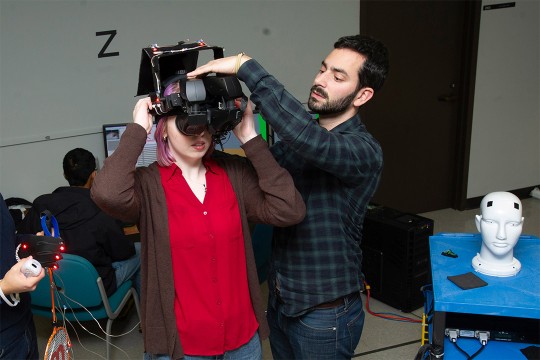News by Topic: Imaging Science
-
January 26, 2021
![of a drone flying over a vineyard.]()
RIT professor developing drone imaging systems to help farmers monitor grapevine nutrients
RIT Professor Jan van Aardt from the Chester F. Carlson Center for Imaging Science is receiving more than $357,000 in funding from the United States Department of Agriculture to help grape growers make data-driven nutrient-management decisions.
-
January 15, 2021
![researcher posing on steps in the College of Science.]()
College of Science experiences boom in sponsored research
Several School of Physics and Astronomy faculty secured large grants as principal investigators during a banner summer.
-
January 15, 2021
![researcher setting up a drone on a roadway.]()
Research takes flight at Tait Preserve
Scientists began conducting research at the Tait Preserve of RIT for the first time this summer. Researchers from the Digital Imaging and Remote Sensing Laboratory were the first to use the site, collecting data using imaging technology flown on unmanned aerial systems, or drones.
-
January 6, 2021
![Graphic of man in gray suit with words: Connections with Evan Dawson.]()
Connections: Is Rochester becoming a hub for the field of textual science?
WXXI’s “Connections” program features Roger Easton, professor in the Chester F. Carlson Center for Imaging Science; Lisa Enochs, second-year student double majoring in motion picture science and imaging science; and Zoë LaLena, second-year imaging science student.
-
December 11, 2020
![professor posing with a LiDAR camera.]()
RIT imaging scientist receives funding to improve how LiDAR can be used to study forests
Imaging scientists at RIT have several new projects in the works to improve the way waveform LiDAR can be used to study forests. LiDAR currently does a good job of outlining the top portion of forests, but by using a more complex form of LiDAR, it can reveal much more detail about what lies beneath the forest canopy’s surface.
-
November 18, 2020
![side-by-side images of a 15th-century manuscript, one showing regular text and the other showing text that had been erased.]()
RIT students discover hidden 15th-century text on medieval manuscripts
RIT students discovered lost text on 15th-century manuscript leaves using an imaging system they developed as freshmen. By using ultraviolet-fluorescence imaging, the students revealed that a manuscript leaf held in RIT’s Cary Graphic Arts Collection was actually a palimpsest, a manuscript on parchment with multiple layers of writing.
-
November 13, 2020
![graphic reads: Graduate Education Week, November 16-20.]()
RIT celebrates graduate student research with weeklong virtual symposium Nov. 16-20
RIT will celebrate graduate research during the 13th annual Graduate Education Week and Showcase: A Vision into the Future. The virtual event—Nov. 16 to 20—creates a platform for sharing and exchanging ideas during the COVID-19 pandemic, with pre-recorded and live presentations, demonstrations, visual exhibitions, and an alumni panel discussion.
-
June 23, 2020
![four researchers looking at ancient manuscript.]()
RIT building imaging systems to help libraries and museums uncover lost texts
Scientists from RIT are developing affordable imaging systems to help libraries and museums preserve and expand access to their historical collections. The project, funded by a grant from the National Endowment for the Humanities, aims to create a low-cost spectral imaging system and software that can be used to recover obscured and illegible text on historical documents.
-
June 23, 2020
![three researchers working on a drone.]()
RIT’s Digital Imaging and Remote Sensing Laboratory now offering services to the public
Through the Digital Imaging and Remote Sensing (DIRS) Enterprise Center, customers can now hire faculty and staff from RIT’s Chester F. Carlson Center for Imaging Science to provide training, consulting, data collection, equipment calibration and more in relation to drones, imaging and remote sensing technology.
-
June 5, 2020
![professor helping student put on virtual reality headset.]()
RIT faculty earns NIH grant to use virtual reality to help stroke patients regain lost vision
Scientists from RIT and the University of Rochester aim to use virtual reality to help restore vision for people with stroke-induced blindness. The team of researchers led by RIT's Gabriel Diaz, are developing a method they believe could revolutionize rehabilitation for patients with cortically induced blindness, which afflicts about 1% of the population over age 50.
-
May 1, 2020
![student wearing sunglasses highlights paper under colorful light.]()
First-year students develop imaging system to study historical artifacts
A multidisciplinary team of first-year students has been working to develop an imaging system that can reveal information hidden in historical documents for their Innovative Freshmen Experience project-based course. But with the shift to remote classes, the students left campus with the device nearly complete. Although disappointed, they shifted focus to the opportunities the new situation would create.
-
April 23, 2020
![researcher pointing at equations on dry-erase board.]()
Fixing the forgetting problem in artificial neural networks
An RIT scientist has been tapped by the National Science Foundation to solve a fundamental problem that plagues artificial neural networks. Christopher Kanan, an assistant professor in the Chester F. Carlson Center for Imaging Science, received $500,000 in funding to create multi-modal brain-inspired algorithms capable of learning immediately without excess forgetting.






















